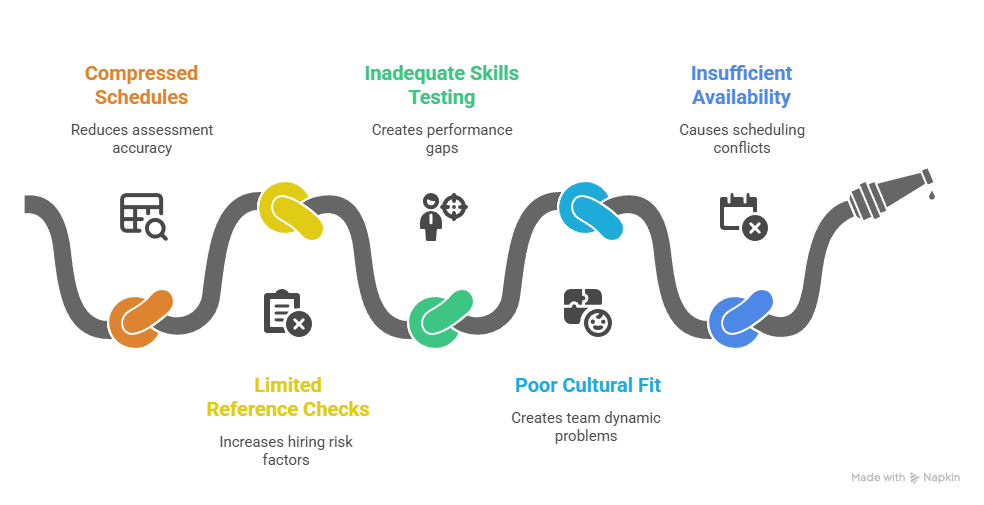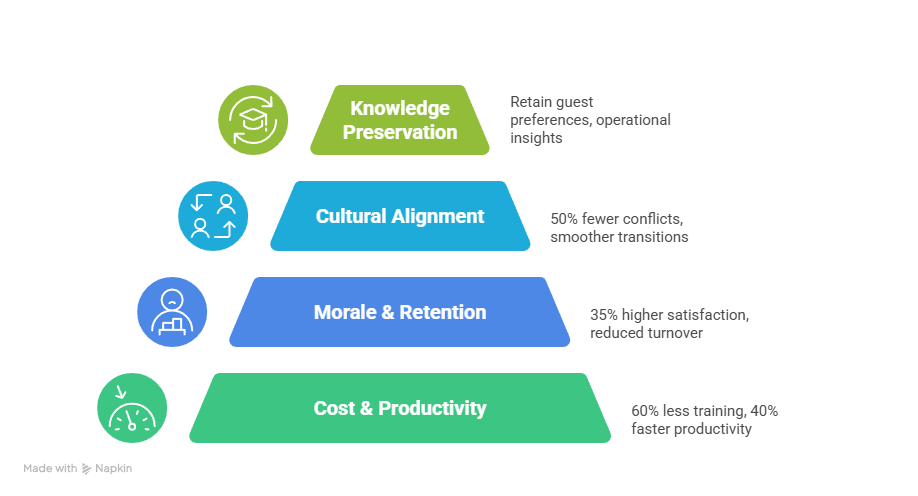Poor hiring decisions in the hospitality industry can cost businesses between $15,000-$75,000 per bad hire when factoring in recruitment, training, turnover, and operational disruptions. Implementing proper screening processes and background checks reduces these costly mistakes by up to 70%.
Key Takeaways
- Bad hiring decisions cost hospitality businesses an average of $42,000 per employee when including recruitment, training, and turnover expenses.
- Skipping background checks leads to 40% higher turnover rates and exposes businesses to theft, liability issues, and guest safety concerns.
- Inadequate reference verification results in 60% more performance issues and customer service complaints within the first 90 days.
- Rushed hiring during peak seasons increases bad hire rates by 35% and creates long-term staffing problems that compound operational costs.
- Poor job descriptions attract wrong candidates, wasting 25-30 hours of management time per unsuitable applicant interviewed.
- Ignoring cultural fit assessment causes 50% of hospitality employees to leave within six months, creating continuous recruitment cycles.
The True Cost of Hospitality Hiring Mistakes
Hospitality hiring mistakes create cascading financial impacts that extend far beyond initial recruitment expenses. Industry research shows that replacing a front-line hospitality worker costs between $15,000-$20,000. Management positions can exceed $75,000 in total replacement costs. These figures include direct expenses like advertising, interviewing time, background screening, training, and lost productivity during transition periods.
The hidden costs often prove more damaging than obvious expenses. Poor hires damage guest satisfaction scores, reduce team morale, and create operational inefficiencies. These problems ripple throughout the organization. Customer complaints increase by an average of 23% when businesses employ unsuitable staff members. This directly impacts online reviews and repeat business rates. Bad hiring decisions force existing employees to compensate for underperformers. This leads to burnout and additional voluntary turnover among previously stable team members. The cycle of poor hiring creates a domino effect that can cripple hospitality operations for months.
Labor shortage issues in 2025 have made hiring mistakes even more expensive. Properties struggle to find replacement workers quickly. This means bad hires often stay longer, causing more damage to operations and guest experiences. The current market conditions have increased the true cost of hiring mistakes by approximately 15% compared to previous years.
Skipping Proper Background Check Screening Process
Background check negligence represents one of the most expensive hospitality hiring errors. Yet 34% of hospitality businesses still skip comprehensive screening to save time and money. This false economy backfires dramatically. Hospitality workers handle cash, access guest rooms, and interact directly with vulnerable travelers. The screening process should include criminal history verification, employment history confirmation, and reference checks. These must be tailored to hospitality-specific risks.
| Screening Component | Cost | Risk Reduction |
| Criminal Background Check | $25-$50 | 65% theft reduction |
| Employment Verification | $15-$30 | 40% performance improvement |
Proper background screening reduces employee theft by 65%. It also improves overall job performance by 40% according to hospitality industry studies. These improvements translate directly into reduced insurance claims and fewer customer complaints. Lower turnover rates occur throughout the organization as well.
The hospitality industry faces unique security challenges in 2025. Guest safety concerns have increased following several high-profile incidents at hotels nationwide. Properties that skip background checks face higher insurance premiums and potential liability lawsuits. Some insurance companies now require comprehensive background screening as a condition of coverage.
Rushing the Interview Process During Peak Seasons
Peak season hiring pressure causes hospitality managers to compress interview processes. This leads to poor candidate evaluation and costly hiring errors. Summer resorts, ski lodges, and holiday-dependent businesses often sacrifice thorough screening. They do this for quick staffing solutions. This rushed approach increases bad hire rates by 35%. It creates staffing problems that persist long after peak seasons end.
Seasonal hiring mistakes compound because poor performers often stay through busy periods. Termination seems impossible due to staffing shortages. These employees damage service quality during the most critical revenue-generating periods. They create negative guest experiences that impact future bookings. Rushed hires require more supervision and training resources. This happens when management bandwidth is already stretched thin during peak operations.

- Compressed interview schedules reduce candidate assessment accuracy by 40%
- Limited reference checking increases hiring risk factors by 55%
- Inadequate skills testing leads to 30% more operational performance gaps
- Poor cultural fit assessment creates team dynamics problems in 60% of cases
- Insufficient availability verification causes scheduling conflicts in 45% of hires
Successful seasonal hiring requires advance planning and structured processes. These maintain quality standards even under time pressure. Properties that invest in proper hiring protocols during peak seasons report 28% lower turnover rates. They also achieve 15% higher guest satisfaction scores compared to those using expedited hiring methods. The key is starting the hiring process earlier and maintaining standards throughout busy periods.
Inadequate Job Descriptions and Candidate Attraction
Vague or inaccurate job descriptions waste tremendous resources. They attract unsuitable candidates while deterring qualified applicants. Hospitality positions require specific skills, physical capabilities, and personality traits. These must be clearly communicated upfront. Poor job descriptions result in 40% more unqualified applications. They extend the hiring timeline by an average of three weeks.
Generic hospitality job postings fail to convey the unique demands of specific roles. They don't communicate guest service expectations or workplace culture elements. Candidates arrive for interviews with unrealistic expectations. They have wrong ideas about responsibilities, compensation, or working conditions. This mismatch wastes interviewer time and creates negative candidate experiences. It damages the employer brand within local labor markets.
- Physical demands description prevents later accommodation issues: Clear description of lifting, standing, and mobility requirements reduces workers' compensation claims by 25% and eliminates mismatched hires who cannot perform essential job functions. Properties must specify exact physical requirements to avoid legal complications and ensure operational efficiency throughout employment periods.
- Schedule flexibility communication reduces early turnover: Honest communication about evening, weekend, and holiday work requirements decreases turnover by 30% among candidates seeking traditional schedules. Many hospitality applicants underestimate the demanding schedule requirements and leave quickly when reality doesn't match expectations. Transparency during recruitment saves significant replacement costs and training investments.
- Guest interaction intensity explanation helps candidate self-selection: Detailed explanation of customer service demands allows candidates to evaluate personality fit and communication skills accurately. High-intensity guest interaction roles require specific temperaments and stress management abilities that not all applicants possess naturally. Clear communication reduces mismatched hires by 45% and improves guest satisfaction scores significantly.
Well-crafted job descriptions reduce unqualified applications by 60%. They improve candidate quality scores by 45% according to recent hospitality recruitment studies. The investment in detailed job descriptions pays immediate returns through better candidate pools and reduced screening time.
Ignoring Cultural Fit Assessment
Team Dynamics and Service Standards
Cultural fit assessment often gets overlooked in favor of technical skills evaluation. Yet hospitality success depends heavily on personality alignment with service standards and team dynamics. Employees who don't match the organizational culture create friction with coworkers. They struggle to meet guest service expectations and typically leave within six months. This cultural mismatch costs an average of $18,000 per employee. The costs include recruitment, training, and turnover expenses.
Hospitality businesses with strong service cultures require specific personality types. Employees must genuinely enjoy helping others and thrive in fast-paced environments. They need to maintain positive attitudes under pressure. Technical skills can be taught through training programs. However, personality traits and service orientation prove much harder to develop. Properties that hire for attitude and train for skill see better long-term results.
Long-term Retention Impact
Cultural fit directly correlates with employee retention rates and job satisfaction scores in hospitality settings. Workers who align with company values and team dynamics stay an average of 18 months longer. This happens compared to those who don't fit culturally. Extended tenure reduces ongoing recruitment costs and creates more experienced service teams. These teams deliver better guest experiences consistently.
Properties that prioritize cultural fit during hiring report 35% lower turnover rates. They also achieve 22% higher employee engagement scores. These improvements translate into better guest satisfaction ratings and increased profitability. The benefits come through reduced recruitment and training expenses over time.
Poor Reference and Employment History Verification
Many hospitality employers conduct superficial reference checks. Others skip employment verification entirely. This misses critical information about candidate reliability and performance history. Thorough reference verification reveals patterns of attendance issues, customer service problems, or workplace conflicts. These patterns predict future performance challenges. This hiring mistake costs businesses an average of $31,000 per bad hire. The costs factor in training time, performance management efforts, and eventual replacement expenses.
Employment history gaps or inconsistencies often indicate underlying issues. These problems will resurface in new positions. Hospitality work requires reliability, punctuality, and consistent performance under pressure. These qualities are best evaluated through previous employer feedback. Reference conversations provide insights into training needs and supervision requirements. They also uncover potential red flags that interviews alone cannot reveal.
| Reference Type | Information Gained | Cost of Skipping |
| Direct Supervisor | Performance and reliability patterns | $8,000 in training waste |
| HR Department | Eligibility for rehire and policy violations | $12,000 in turnover costs |
| Peer References | Team dynamics and cultural fit indicators | $15,000 in replacement expenses |
Professional reference verification services cost $25-$75 per candidate. However, they prevent hiring mistakes that average $31,000 in total impact costs. The return on investment exceeds 400%. This considers reduced turnover, improved performance, and decreased management time spent on problem employees. The verification process also provides valuable insights for onboarding and training planning.
Neglecting Skills Testing and Practical Assessment
Hospitality positions require specific technical skills, customer service abilities, and problem-solving capabilities. Traditional interviews cannot fully evaluate these competencies. Skills testing reveals competency gaps before hiring rather than discovering them during expensive training programs. It also prevents learning about them through guest complaints. Properties that skip practical assessments experience 45% more performance issues. They also have 30% higher training costs compared to those using comprehensive evaluation methods.
Customer-facing roles particularly benefit from scenario-based testing. These simulate real guest interactions, complaint resolution, and service recovery situations. Assessments predict job success more accurately than interview responses alone. They help identify candidates who perform well under pressure. Practical testing provides realistic job previews that help candidates make informed decisions about role fit.
- Customer service scenarios through role-playing exercises: These reveal communication skills and service recovery abilities under realistic pressure situations and help identify candidates who remain calm and professional during difficult guest interactions.
- Technical skill demonstrations using actual equipment: Hands-on testing of POS systems, reservation software, or food service equipment prevents costly training failures and ensures candidates can perform essential job functions from day one.
- Problem-solving assessments through situational judgment: These tests identify candidates who can think critically and make appropriate decisions independently without constant supervision or management intervention during busy operational periods.
- Language proficiency verification for guest communication: Speaking and comprehension testing ensures effective guest communication in multilingual hospitality environments and prevents misunderstandings that could damage guest satisfaction scores significantly.
- Physical capability assessments for job requirements: Job-relevant fitness testing prevents workers' compensation claims and accommodation issues after hiring while ensuring candidates can meet the physical demands consistently throughout employment.
Comprehensive skills testing reduces training time by 25%. It improves 90-day performance ratings by 40% across all hospitality positions tested. The upfront investment in proper assessment saves significant costs in training, supervision, and performance management later.
Overlooking Internal Promotion Opportunities
External recruitment often overlooks qualified internal candidates. These employees understand company culture, systems, and guest service standards. Internal promotion costs 50% less than external hiring. It provides better cultural fit and faster productivity ramp-up times. Internal advancement opportunities improve employee retention and create career development pathways. These paths attract quality candidates to entry-level positions.
Existing employees require less orientation training. They understand established procedures and maintain relationships with current team members. They also possess institutional knowledge about guest preferences and operational challenges. Internal employees know effective problem-solving approaches that external hires must learn from scratch. However, internal promotion requires succession planning and skill development programs. Many hospitality businesses neglect these until facing immediate staffing needs.

- Reduced training costs and faster productivity: Internal promotions require 60% less training time and reach full productivity 40% faster than external hires who must learn all systems and procedures from the beginning.
- Improved employee morale and retention rates: Visible promotion opportunities increase employee satisfaction by 35% and reduce turnover among ambitious team members who see clear advancement paths within the organization.
- Better cultural alignment and team integration: Internal promotions maintain established relationships and cultural understanding, leading to 50% fewer team conflicts and smoother operational transitions during role changes.
- Institutional knowledge preservation and continuity: Promoted employees retain valuable knowledge about guest preferences, operational quirks, and effective problem-solving methods that new external hires cannot provide immediately.
The 2025 labor market makes internal promotion even more valuable. External candidates often demand higher salaries and better benefits. Internal employees typically accept promotions with smaller salary increases. They value the advancement opportunity and job security more than maximum compensation.
Failing to Plan for Seasonal Workforce Needs
Seasonal hospitality businesses often wait until the last minute to begin hiring. This creates panic hiring situations that lead to poor decision-making. Advance workforce planning prevents rushed hiring and allows for proper screening processes. Properties should begin recruiting 6-8 weeks before peak seasons. This provides adequate time for background checks, reference verification, and skills assessment.
Last-minute hiring also limits the candidate pool significantly. Quality candidates often secure employment elsewhere while businesses delay their hiring processes. Seasonal workers who are still available close to peak season may have been rejected by other employers. This creates a selection bias toward lower-quality candidates. Early hiring provides access to the best available seasonal workforce and reduces competition with other hospitality businesses.
The 2025 seasonal hiring market has become increasingly competitive. Workers have more choices and higher expectations. Properties that start hiring early gain significant advantages in candidate selection and negotiation leverage. They can also provide better onboarding and training experiences when not rushed by immediate operational needs.
Underestimating Training and Onboarding Requirements
Many hospitality businesses underestimate the time and resources required for proper employee training. Inadequate training leads to poor performance, guest complaints, and early turnover. New hires need comprehensive training on systems, procedures, and service standards. They also need time to develop confidence and competence in their roles. Rushed training programs create employees who struggle to meet performance expectations.
Effective onboarding extends beyond basic job training. It includes cultural integration, relationship building, and performance expectation setting. Properties with structured onboarding programs report 25% higher retention rates and 30% better performance scores. The investment in proper training prevents costly mistakes and creates more capable, confident employees.
Conclusion
Hospitality hiring mistakes create expensive consequences that extend far beyond initial recruitment costs. Bad hires cost businesses an average of $42,000 each through turnover, training waste, and operational disruption. Implementing comprehensive screening processes reduces these costly errors by up to 70%. This includes thorough background checks and skills assessments that improve guest satisfaction and employee retention rates. Successful hospitality hiring requires proper job descriptions, cultural fit evaluation, and structured interview processes. These maintain quality standards even during peak season pressure. The 2025 labor market has made quality hiring even more critical as competition for workers intensifies. The investment in proper hiring protocols pays substantial returns through reduced turnover, improved performance, and enhanced guest experiences that drive long-term profitability.
Frequently Asked Questions
What is the average cost of a bad hire in the hospitality industry?
Bad hires in hospitality cost between $15,000-$75,000 per employee, with front-line positions averaging $42,000 in total impact including recruitment, training, turnover, and operational disruption costs.
How much can proper background screening reduce hospitality hiring mistakes?
Comprehensive background screening processes reduce hiring mistakes by up to 70% and decrease employee theft by 65% while improving overall job performance by 40% in hospitality settings.
What are the most expensive hospitality hiring errors to avoid?
The costliest hiring mistakes include skipping background checks, rushing interviews during peak seasons, neglecting cultural fit assessment, and inadequate reference verification, each costing $15,000-$45,000 per incident.
How do rushed hiring decisions during peak seasons affect costs?
Rushed peak season hiring increases bad hire rates by 35% and creates staffing problems that persist beyond busy periods, resulting in 28% higher turnover rates and decreased guest satisfaction scores.
What should be included in the hospitality background check screening process?
Comprehensive hospitality screening should include criminal history verification, employment history confirmation, reference checks, and skills testing tailored to customer service and cash handling responsibilities.
How does cultural fit impact hospitality employee retention and costs?
Poor cultural fit causes 50% of hospitality employees to leave within six months, costing an average of $18,000 per employee, while good cultural alignment extends tenure by 18 months and reduces turnover by 35%.
Additional Resources
- Fair Credit Reporting Act (FCRA) Compliance for Employers
https://www.ftc.gov/enforcement/rules/rulemaking-regulatory-reform-proceedings/fair-credit-reporting-act - U.S. Department of Labor Hospitality Industry Employment Standards
https://www.dol.gov/agencies/whd/industries/hospitality - American Hotel & Lodging Association Employment Resources
https://www.ahla.com/workforce-development - National Restaurant Association Hiring Best Practices
https://restaurant.org/manage-my-restaurant/operations/workforce/hiring-best-practices
Still have questions?
Get in touch with our team today for a personalized demo and discover how our tailored volume pricing and packages can drive results for your business!
How useful was this page?*
Note: your comments are anonymous. We use them to improve the website. Do not include any personal details.
Visit our FCRA Compliance Tool or leave a message here if you need a response.
From the blog Explore the GCheck Content Hub

How Long Does a Background Check Take? A Complete 2025 Guide
13 Dec, 2023 • 14 min read
The Ultimate Background Check Guide
13 Dec, 2023 • 4 min read
The Ultimate Guide to Employment Background Checks
13 Dec, 2023 • 10 min readThe information provided in this article is for general informational and educational purposes only and should not be construed as legal advice or a substitute for consultation with qualified legal counsel. While we strive to ensure accuracy, employment screening laws and regulations—including but not limited to the Fair Credit Reporting Act (FCRA), Equal Employment Opportunity Commission (EEOC) guidelines, state and local ban-the-box laws, industry-specific requirements, and other applicable federal, state, and local statutes—are subject to frequent changes, varying interpretations, and jurisdiction-specific applications that may affect their implementation in your organization. Employers and screening decision-makers are solely responsible for ensuring their background check policies, procedures, and practices comply with all applicable laws and regulations relevant to their specific industry, location, and circumstances. We strongly recommend consulting with qualified employment law attorneys and compliance professionals before making hiring, tenant screening, or other decisions based on background check information.

